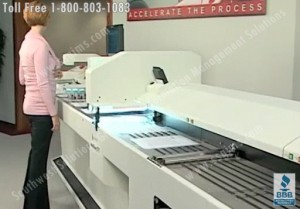Posts Tagged ‘document scanning’
Is There a Real ROI for Document Scanning?
In the World of Document Scanning It’s Time to Stop Playing Games
I have conducted hundreds of assessments for companies and government agencies of all sizes over the past 20 years that we interested in document scanning. My consulting style is straightforward and direct, and my recommendations are always based on actual existing conditions as opposed to presumed processes. Although it’s not always easy to hear, most management and executive teams can quickly grasp the big picture of problem identification to resolution. They see it from a three dimensional perspective that includes operations, sales, compliance, and customer service. It is more efficient to gather those who may be vested in the results of a decision at the start of the process rather than trying to repeat and/or “sell” the concept later in the game and expending time and resources on “playing the procurement” game.
Document Scanning ROI is More Complex than Just Line Items and Hard Cost Components
One of the best pieces of advice I received early in my career came from a self-proclaimed dogmatic CFO who had an open disdain for sales; this guy could spin numbers faster than Rain Man. His response to my extensive document scanning ROI analysis was short, but definitely not sweet. He said, “Don’t ever try to sell a ROI to a numbers guy; you will always lose”. There’s no great ending to the story. They didn’t launch the document scanning project, and I didn’t have a slick comeback. His advice, however, made perfect sense. Line item document scanning ROI analyses look great when the hard cost components are equalized, but measuring soft costs associated with the benefits of technology, resource efficiencies (LEAN principles such as wasted human talent), or progress can be tricky.
What’s in the Box?
At the end of the day, some decisions are made because they make sense despite the balance sheet. For example, some organizations dismiss document scanning when compared to storing documents off-site. Why pay $100-$150 to scan a box of documents when it can be stored off-site for $6 a year? It could take 25 years to see a ROI on that expense, assuming the box is even kept that long. And in many cases, this is a solid argument. The problem with this scenario, however, is that the decision is typically made across the board for all documents, each having a unique set of criteria.
Additionally, this scenario is supported by a list of assumptions. For example, this ROI assumes that the documents are never retrieved again (if so, there are costs associated with retrieval, transportation, and re-filing). It also assumes that the contents of each box have been documented and that someone is managing the retention to ensure the box is destroyed at some point. If not, then the yearly cost is infinite. Over time, a combination of loose policy and continued personnel turnover can result in significant off-site storage bills for thousands of boxes. Does anyone really know what’s in most of those boxes? It’s pretty amazing what we find when we do an off-site storage assessment. Un-labeled boxes filled with Christmas decorations, or boxes labeled “John’s right side drawer”. We once located a large volume of boxes that had been labeled “Not sure”. We can laugh about it now, but I can assure you that no one was laughing at the time! Even boxes that have descriptions are destined to live off-site forever because with all the publicity surrounding the destruction of documents; no one wants to pull the trigger to shred.
The Soft Costs Associated with Managing Paper
There is also the litany of soft costs that, although very real, do not have predetermined values. For example, the cost to reproduce documents or information that may already exist is like paying a bill twice; we don’t know what we don’t know. The “simple math” storage cost comparison of document scanning versus off-site storage usually doesn’t include all the costs associated with managing paper: file folders; labels; boxes; storage equipment; labor to create and retrieve files; searching for missing files; interfiling documents; copy documents; or the physical space to store them before they go off-site. Depending on the values each organization might assign to the cost of managing paper, the ROI for document scanning can spin in a million directions. This type of analysis usually focuses on the financial impact of a proposed business decision, but that’s like comparing the cost of typewriters to computers. If we had the same approach back then, we would still be loading carbon paper.
Now don’t go running off to scan everything in off-site storage! The sins of the past may be best handled in a different way. But you can stop the bleeding. At some point, there is a stage in the lifecycle when paper not only starts to lose its value, but also can actually cost more than you bargained for.
Keep Moving Forward with the Digital Data Imaging Migration
Ultimately, there is an element of progress that will be difficult to quantify and yet will likely provide the most sound data towards the digital data imaging migration decision. Remember the typewriter analogy? The cost differential was vast and the benefits were not only uncertain, but also rarely utilized to their full potential. That still holds true today, but organizations nevertheless need to keep moving forward. Hopefully, we will do so having learned something along our technology journey. Forward progress isn’t taken in a single step; it’s a process.
——————————————————————————————————————————————————————————————-
Anna Stratton is Director of Information Management Solutions at Southwest Solutions Group headquartered in Dallas, Texas. Anna specializes in records management and business process protocols, document scanning, policy design, and information retention policies and process. Anna has over 18 years of professional business management experience and provides advice nationwide through the SYSTEC Group’s “Ask the Expert” column. Ms. Stratton is also a dynamic national speaker and conducts private corporate seminars on a variety of topics in addition to providing keynote and educational speeches for organizations such as ARMA and the Lorman Seminar Group. Ms. Stratton has been recognized by Cambridge Who’s Who for demonstrating dedication, leadership and excellence in information and asset management.Document Scanning isn’t an All or Nothing Proposition
Don’t Sell Me!
There is nothing more frustrating than someone trying to sell you something – regardless if you need it or not. Nothing infuriates me more than vendors who walk into a client’s office with a cute little portable scanner, a stack of paper, and a promise of life in digital Shangri-La! Document scanning isn’t about putting paper through a machine. It’s also not an “all or nothing” proposition. I visit with clients who have thousands of files that occupy miles of space and require scores of resources who have been lulled into thinking that the only way to stop the bleeding is to spend millions of dollars on document scanning. The result is that each year the paper grows and their perception of change only get more expensive.
Getting Started with Document Scanning
Migrating to the electronic document world can involve a lot of steps, but as someone once told me, I can guarantee you will never score if you don’t shoot! We don’t need enterprise wide spends to get started and quite frankly, it’s why so many organizations have been burned. The key is identifying a core document type or file set that brings you the best return (we’ll talk about ROI soon) and allows you to ease your way into the change. For example, you can start with scanning documents from your most recent year or perhaps consider core documents within a file that have a high retrieval rate. Maybe you have documents that are mission critical and the only copy you have is in paper format. The key to getting started with document scanning is not feeling the pressure to bang it all out at once but having a conversation about where it makes sense to start. We have clients that send us one box a week or sometimes just one box a month! At the end of the year, they’re 100,000 pages farther along than they were before or at least they haven’t added to the mountain they already have.
Understanding How Document Scanning Will Work for You
With today’s advancements in technology and process efficiencies, there are few organizations that cannot afford to begin outsourcing this task. The options today are almost unlimited and creative approaches – not pre-determined solutions – should be the way we approach our options. Putting paper through a scanner is not rocket science. The key to success is understanding how those documents are being used, why those documents should (or in some cases, shouldn’t be) scanned, and making sure that whatever you do today will work as you progress into new technology applications and platforms. I’ll say it again – there is no one size fits all solution – but there are many document scanning solutions and the right one needs to be the one that works best for you.
——————————————————————————————————————————————————————————————-
Anna Stratton is Director of Information Management Solutions at Southwest Solutions Group headquartered in Dallas, Texas. Anna specializes in records management and business process protocols, document scanning, policy design, and information retention policies and process. Anna has over 18 years of professional business management experience and provides advice nationwide through the SYSTEC Group’s “Ask the Expert” column. Ms. Stratton is also a dynamic national speaker and conducts private corporate seminars on a variety of topics in addition to providing keynote and educational speeches for organizations such as ARMA and the Lorman Seminar Group. Ms. Stratton has been recognized by Cambridge Who’s Who for demonstrating dedication, leadership and excellence in information and asset management.The First Step of Digital Data Imaging Migration: Problem Identification
Embracing Technology at Home
My Dad was 75 years old when we insisted he learn how to use a computer so we could communicate via email. Today, at 90 years old, he would be lost if he couldn’t send an email or check his accounts from the comfort of his home. My 20-something kids can’t fathom looking at a map or printing out a document, and I’m pretty sure none of them have ever actually seen a fax machine. As for me, I’m taken back when someone asks me to write a check (do they expire if you don’t use them for ten years?). I don’t want a paper receipt that I can lose. I complete applications online and execute contracts at 30,000 feet from my window seat, and most of us would be hard pressed to say we would prefer to go back to filing our taxes on paper forms. We can justify and embrace digital documents from home base, but why do we resist them and digital data imaging in the workplace?
Why are We Still Pushing Paper?
I work with hundreds of organizations that still push mounds of paper through their AP department. Resources are spent opening mail, routing paper, making copies, acquiring signatures, creating checks, and applying postage. You don’t have to be a CFO to know that our old comfortable processes are contrary to our objectives. So where is the logic? One contributing factor is likely job security, especially in today’s uncertain economy. It’s a fear unfounded and typically based in poor communication at a higher level. Getting more efficient doesn’t always mean a reduction in head count; it means we get more value for our dollar. It’s a lean concept that is widely accepted to address “wasted human talent.” Truth be told, most individuals would embrace an opportunity to utilize more of their analytical skills than they would their dexterity capabilities.
Another reason for the hesitancy to embrace digital data imaging may be one that plagues us in every area imaginable: being burnt. Early attempts at digital data imaging migration may not have been a good experience and access to technology without training and a succinct roadmap leaves most of us lost and frustrated. What do we call it? Where do we store it? How do we access it, and who is securing it? There’s added anxiety with the simultaneous introduction of new software applications and of course the ever-present compliance confusion; “Is a digital copy a copy or an original”? If it’s an original can I destroy the paper? As organizations start to delve into the details of digital data imaging migration, paralysis eventually replaces progress, and if organizations are able to get past the initial deterrents of digital data imaging migration, most will eventually stall out at the budget phase, despite the undisputed value on the bottom line.
Digital Data Imaging Migration Solutions Start with Identifying Your Unique Need
So is there a solution? The answer is “no.” There isn’t “a” solution, but there are “many” solutions. Problems arise when organizations try to align themselves with “a solution” before identifying their own unique need. Technology is a tool not a solution. Policy and processes are tools as well. Scanning documents and workflow and cloud storage are all components that may contribute to a solution, but we can be easily lulled into believing that any one of these components is a stand-alone solution.
Once an organization understands the process of “problem identification”, they can start to build a solution that addresses core business objectives rather than slipping into a “one size fits all solution”.
——————————————————————————————————————————————————————————————-
Anna Stratton is Director of Information Management Solutions at Southwest Solutions Group headquartered in Dallas, Texas. Anna specializes in records management and business process protocols, document scanning policy design, and information retention policies and process. Anna has over 18 years of professional business management experience and provides advice nationwide through the SYSTEC Group’s “Ask the Expert” column. Ms. Stratton is also a dynamic national speaker and conducts private corporate seminars on a variety of topics in addition to providing keynote and educational speeches for organizations such as ARMA and the Lorman Seminar Group. Ms. Stratton has been recognized by Cambridge Who’s Who for demonstrating dedication, leadership and excellence in information and asset management.Merging Paper and Electronic Documents | The Digital Data Imaging Migration
I Am a Member of Paper Lovers Anonymous
I’m going to say what none of us want to admit; I like paper! Yes, I use my iPhone and iPad to manage almost every aspect of my life, and I love the ease of electronic transactions and mobility. I want to take part in the progress and the digital data imaging migration, but there are just some areas in my world where paper still works better than electronic documents. I know how to find it (yes, there is a system to those piles), and I know what to do with it. Most of us have just figured out how to use those darn all-in-one copy machines and the thought of learning yet another way is just too daunting to even think about!
The Frustration We Experience Using Electronic Documents
In the same breath, we say we’re OK with change too, (as long as it’s associated with something like winning the lottery). We use electronic documents but don’t always mange them well. We have folder structures that go ten deep that made a lot of sense when we created them but are now the cause of carpel tunnel for all the clicks required to get to a single document. So, we save a document to our desktop where we know we can find it; except now our monitors have become mirrors of chaos that make us long for those paper file folders. In our infinite wisdom, we print those documents so that we can finally get to work on what started the search in the first place and for a single moment we feel a sense of control and inner peace. It’s no wonder digital data imaging is met with such resistance. Before we can really begin thinking about digital data imaging, electronic documents, and document scanning, we need to accept that there is a place for both paper and electronic documents and that the transition cannot be a quantum leap!
A New Perspective on the Paper vs Electronic Documents Conundrum
This is not a “how to” series, but rather a new perspective on how we handle the paper vs electronic document conundrum. The battle will continue between the paper lovers and the digitally determined until we start to recognize what it is we’re all actually battling about. It’s possible that we can continue with forward progress and still allow for a transitional comfort zone. I think both teams get a bad rap. The IT group is under the gun to find new ways for information to be useful while the departments have a confidence issue and are so busy trying to get their work done that they don’t have time to adapt to new ways.
It’s Time for Paper and Electronic Documents to Work Together
I don’t want to get all “rainbows and puppy dogs” here, but at some point we need to figure out how to understand each other. I sit at the table with department managers, IT directors and C-suite executives and no one speaks the same language. The pressure to stay current and relevant is real, but we can’t ignore the core business functions or the people performing them because we risk that the journey to the clouds is going to be a bumpy ride. The good news is that the sun does shine above those clouds (I promise that’s the last sappy statement I’ll make). Trying to figure how to deal with all the paper of the past, the paper we still use, and the paper we don’t want to create anymore includes technology, outsourcing, financial, and change management considerations. Trying to ice out one of those aspects will either paralyze organizations from doing anything or at the minimum, ruffle enough feathers along the way to warrant resistance.
Join me as we navigate through the world of digital data imaging and document scanning and talk about real world scenarios that include problem identification, understanding ROI, and managing changes along the way.
——————————————————————————————————————————————————————————————-
Anna Stratton is Director of Information Management Solutions at Southwest Solutions Group headquartered in Dallas, Texas. Anna specializes in records management and business process protocols, document scanning, policy design, and information retention policies and process. Anna has over 18 years of professional business management experience and provides advice nationwide through the SYSTEC Group’s “Ask the Expert” column. Ms. Stratton is also a dynamic national speaker and conducts private corporate seminars on a variety of topics in addition to providing keynote and educational speeches for organizations such as ARMA and the Lorman Seminar Group. Ms. Stratton has been recognized by Cambridge Who’s Who for demonstrating dedication, leadership and excellence in information and asset management.Document Scanning Services | Converting Records to Digital Imaging
Our Document Scanning Services for Converting Records to Digital Imaging Safely and Efficiently
 We offer document scanning services to speed up the process of converting records to digital imaging. Using state of the art scanning equipment, we are able to provide document scanning services for converting records to digital imaging securely, affordably and quickly. We work with clients that range from small businesses to very large corporations across all industries, to help migrate your scanned documents across the enterprise to ensure the availability, integrity, and longevity of your records and information. Our document scanning services can stand alone, but we also offer records management consulting to help you create a complete program for document and data management. We will help you plan for the unexpected with our disaster recovery planning services to ensure the integrity of your business. Whether its microfilm, paper, microfiche, or a combination, our clients rely on us to manage and digitize their business critical information.
We offer document scanning services to speed up the process of converting records to digital imaging. Using state of the art scanning equipment, we are able to provide document scanning services for converting records to digital imaging securely, affordably and quickly. We work with clients that range from small businesses to very large corporations across all industries, to help migrate your scanned documents across the enterprise to ensure the availability, integrity, and longevity of your records and information. Our document scanning services can stand alone, but we also offer records management consulting to help you create a complete program for document and data management. We will help you plan for the unexpected with our disaster recovery planning services to ensure the integrity of your business. Whether its microfilm, paper, microfiche, or a combination, our clients rely on us to manage and digitize their business critical information.
Is it Time for Your Business to Move From Paper to Digital Imaging?
Are you wondering if it’s time for your business to move from paper to digital imaging? Studies have shown that workers waste 20 to 40 percent of their time searching for paper documents manually. Ironically, we only spend 5 to 15 percent of our time reading the information. Because 90 percent of our corporate information still resides on paper, having the information where you need it, when you need it is often challenging. Also, when the information is no longer current, we spend even more resources retrieve it, box it, store it, and manage retention schedules. (Read more about digital imaging readiness)
To find out more information on our document scanning services for converting records to digital imaging, just give us a call at 1-800-803-1083 or send us an email. We will put you in touch with one of our records management consultants that will provide you with more details and guide you through the digital imaging process.
10 Steps to Converting Electronic Medical Records (EMR)
Why Electronic Medical Records (EMR)?
 Healthcare providers all across the U.S. are migrating their medical charts to Electronic Medical Records (EMR) to increase record accuracy, decrease waste, eliminate costly storage space, and improve patient care. Hospitals are also seeking to take advantage of government incentives under the American Recovery and Reinvestment Act (ARRA). Right now, everyone is focusing on the “carrot” of payments they can receive by implementing EMR. But the “stick” comes out in 2015, when hospitals that don’t meet federal guidelines for paperless records may be penalized with reduced Medicare reimbursements.
Healthcare providers all across the U.S. are migrating their medical charts to Electronic Medical Records (EMR) to increase record accuracy, decrease waste, eliminate costly storage space, and improve patient care. Hospitals are also seeking to take advantage of government incentives under the American Recovery and Reinvestment Act (ARRA). Right now, everyone is focusing on the “carrot” of payments they can receive by implementing EMR. But the “stick” comes out in 2015, when hospitals that don’t meet federal guidelines for paperless records may be penalized with reduced Medicare reimbursements.
What’s Holding Healthcare Organizations Back from Using EMR?
 The new government rules to EMR are confusing and picking the right document imaging software system is challenging. Plus, there is significant expense and disruption involved when you make such a big change in how medical records are handled. It’s just not feasible to expect hospitals to do this on their own without expert guidance from information management professionals. Software vendors are happy to sell you imaging hardware and advise you on how to install image software on your computer network; but that doesn’t help with the real-life obstacles you will face in converting your medical file charts to electronic images that can be located when you need them.
The new government rules to EMR are confusing and picking the right document imaging software system is challenging. Plus, there is significant expense and disruption involved when you make such a big change in how medical records are handled. It’s just not feasible to expect hospitals to do this on their own without expert guidance from information management professionals. Software vendors are happy to sell you imaging hardware and advise you on how to install image software on your computer network; but that doesn’t help with the real-life obstacles you will face in converting your medical file charts to electronic images that can be located when you need them.
 Getting Help Converting Electronic Medical Records
Getting Help Converting Electronic Medical Records
Converting medical records to a document imaging system takes the help of a qualified information management specialist who has experience in the EMR imaging process and government requirements. A qualified information management specialist will help you understand the process and avoid common mistakes that can set your organization back. For example, EMR compatible medical records scanning involves more than simply scanning records and uploading a pdf of a patient’s chart into a database. If you don’t have federally approved quality controls in place, you may end up with a bunch of electronic records that are not considered true originals. That’s an excuse Medicare can use to deny payment. Below is an overview of ten steps to converting your medical documents to Electronic Medical Records.
10 Steps to Converting Your Paper Medical Records to EMR
1. Survey – Review your current filing system to discover the best documents to image 2. Plan – Develop a master plan to map and document every step of the conversion process including establishing your document indexing requirements 3. Pack & Manifest – Box and label medical charts/records to be imaged so they can be tracked throughout the conversion process 4. Secure Transportation – Ship record boxes with documents to be scanned and imaged via a bonded courier directly to a secure image conversion facility 5. Validate Receipt – Have the image conversion facility provide receipt of shipment and confirmation documentation of all documents are present 6. Prep & Scanning – The image conversion contractor should prep documents, removing staples and repairing any damaged records before scanning documents with a high quality production scanners to ensure a high quality, clear and complete scan of each file 7. Indexing – Document The image conversion contractor should index documents according to your specifications established in Step Two 8. Quality Control – Request a sampling of imaged documents to ensure scanning and indexing accuracy of each record 9. Output – Upload the scanned records into your EMR software system or supply on CD/DVD if requested 10. Store or Shred – Provide storage, shredding, or secure shipping instructions for paper records
Visit www.ssgims.com or call 1-800-803-1083 for more information on document imaging consulting and conversion services.
Planning Tips For Document Imaging Solutions
 When to Use Document Imaging
When to Use Document Imaging
Document imaging can be a powerful tool but is only a small piece of a records information management (RIM) system. Using document imaging solely for the purpose of solving problems is not practical. The most efficient and logical use of document imaging is for documents that have a high retrieval rate by multiple users, especially in remote areas. Making sure your application is right for document imaging is the first step in the process.
Planning to Image Documents
There are a few basic questions that should be asked (answered) before investigating the implementation of an imaging system:
- What documents do you want to image?
- What is the retrieval rate of these documents (how often are they accessed?)
- How many people access these documents?
- What do you see as the benefits of having these documents available electronically?
More often than not, if the answers to the first three questions are sufficient, determine if further investigation is sensible. However, the fourth question is vital in in starting to address the return on investment question that will undoubtedly come next.
 Solid Solutions for Document Imaging
Solid Solutions for Document Imaging
If having certain documents available electronically aids in the level of customer service, then you could well be on your way to implementing an imaging system. If, however, many of the benefits include issues such as “no more lost or mis-filed items”, then you are probably attempting to drink soup with a fork!
When used specifically to address issues of retrieval and multiple accesses, document imaging is a solid solution. There are also times when certain documents are included in the imaging process as a convenience to upper management. This can be a valid solution for VP’s who have a heavy travel schedule and the need for vital documents on a regular basis. It also provides security for original vital documents without sacrificing access to the information these documents contain.
 Indexing Documents for Efficient Access
Indexing Documents for Efficient Access
If you do move forward with an imaging system, keeping the index system concise and as limited as possible keeps the system user friendly and cost efficient. Scanning documents is easy and scanners are relatively inexpensive. The question is will anyone ever be able to find the document after it has been scanned? Also, remember that you must put your files in order before you scan. An inefficient paper based filing system will translate into a messier electronic document system!
Retaining Documents After Scanning
As for keeping the originals, that depends on what is scanned. If only certain documents are scanned from a file and miscellaneous correspondence or other documentation must be kept, then you might as well keep the scanned original. What is more important is that both the paper and the image is part of a comprehensive retention schedule.
For more information on document imaging and retention scheduling, call us toll free at 1-800-803-1083 or visit www.ssgims.com!




